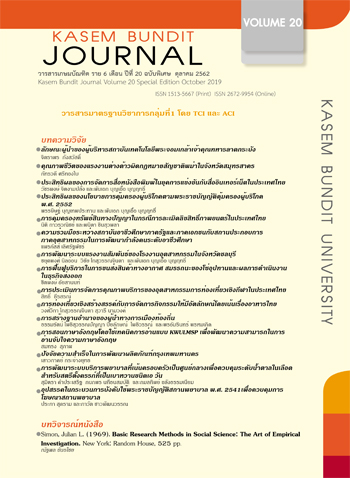การท่องเที่ยวเชิงสร้างสรรค์กับการจัดการกิจกรรมให้มีอัตลักษณ์โดยเน้นเรื่องอาหารไทย
คำสำคัญ:
อัตลักษณ์ กิจกรรม การท่องเที่ยวเชิงสร้างสรรค์ โรงเรียนสอนทำอาหาร อาหารไทยบทคัดย่อ
การศึกษานี้มีวัตถุประสงค์เพื่อวิเคราะห์ปัจจัยการสร้างกิจกรรมให้มีอัตลักษณ์สำหรับการท่องเที่ยวเชิงสร้างสรรค์ โดยเฉพาะอย่างยิ่งแนวความคิดและทฤษฎีอัตลักษณ์ โดยผู้วิจัยได้เลือกกิจกรรมทำอาหารที่เป็นกิจกรรมการท่องเที่ยวอย่างหนึ่งที่ได้รับความนิยมจากนักท่องเที่ยวต่างชาติ และเลือกเก็บข้อมูลด้วยแบบสอบถามจากนักท่องเที่ยวต่างชาติที่ได้ร่วมกิจกรรมเรียนทำอาหาร ที่จังหวัดเชียงใหม่ จำนวน 400 คนผลการวิเคราะห์องค์ประกอบเชิงสำรวจ พบว่า องค์ประกอบเพื่อการสร้างกิจกรรมให้มีอัตลักษณ์ประกอบไปด้วย 6 องค์ประกอบ ดังนี้ คุณค่าและประสบการณ์ การถ่ายทอดเนื้อหาของกิจกรรมให้นักท่องเที่ยว ความจริงแท้ของกิจกรรม กิจกรรมที่มีความแตกต่างจากกิจกรรมการท่องเที่ยวทั่วไป มีความคุ้มค่าที่จะเข้าร่วมกิจกรรม และกิจกรรมที่แตกต่างจากสังคมและชีวิตประจำวัน โดยองค์ประกอบที่ใหญ่ที่สุดคือ องค์ประกอบที่ 1 ซึ่งให้ความสำคัญในการสร้างกิจกรรมให้มีคุณค่าและประสบการณ์ต่อผู้ที่ได้เข้าร่วมทำกิจกรรมนั้น
References
Ashton, S. (2014). Tourist destination brand image development an analysis based on stakeholders' perception: A case study from Southland, New Zealand. Journal of Vacation Marketing, 20(3), 279–292.
Belk, R. W. (1988). Possessions and the Extended Self. Journal of Consumer Research, 15, 139–168.
Bian, Q. & Forsythe, S. (2012). Purchase intention for luxury brands: A cross cultural comparison. Journal of Business Research, 65, 1443-1451.
Burns, D. J. & Warren, H. B. (1995). Need for uniqueness: shopping mall preference and choice activity. International Journal of Retail & Distribution Management, 23(12), 4-12.
Chang, K. C. (2014). Examing the effect of tour guide performance, tourist trust, tourist satisfaction, and flow experience on tourists’ shopping behavior. Asia Pacific Journal of Tourism Research, 19(2), 219-247.
Chang, L. L., Backman, K.F. & Huang, Y. C. (2014). Creative tourism: a preliminary examination of creative tourists’ motivation, experience, perceived value and revisit intention", International Journal of Culture, Tourism and Hospitality Research, 8(4), 401-419,
Chen, C. F. & Tsai, D. C. (2007). How destination image and evaluative factors affect behavioral intentions?. Tourism Management, 28, 1115-1122.
Clark, R. A. & Goldsmith, R. E. (2005). Market mavens: Psychological influences. Psychology & Marketing, 22(4), 289-312.
Costello, A. B. & Osborne, J. W. (2005). Best Practices in Exploratory Factor Analysis: Four Recommendations for Getting the Most From Your Analysis. Practical Assessment, Research & Evaluation. 10(7), 1-9.
Fisher, R. J. & Price, L. L. (1992). An Investigation into the Social Context of Early Adoption Behavior. Journal of Consumer Research, 19(December), 477–486.
Gross, H. E. (1977). Micro and macro level implications for a sociology of virtue: The case of draft protesters to the Vietnam War. Sociological Quarterly, 18(Summer), 319–339.
Heckert, D. M. (1989). The Relativity of Positive Deviance: The Case of the French Impressionists. Deviant Behavior, 10(Spring), 131–144.
Jira Buathong. (2014). Destination Thailand Thailand's index as a destination for tourists. TAT Tourism Journal. Quarter 4/2014 October – December. (In Thai)
Keng, C. J., Tran, V. D., Liao, T. H., Yao, C. J. & Hsu, M. K. (2014). Sequential combination of consumer experiences and their impact on product knowledge and brand attitude: The moderating role of desire for unique consumer products. Internet Research, 24(3), 270-291.
Kron, J. (1983). Home-Psych: The Social Psychology of Home and Decoration, New York: Potter.
Kovathanakul, Donruetai. (2015). Discover Thainess. MICE & Tourism iSaanbiz Week News, March 2015. (In Thai)
Lehto, X. Y., O’Leary, J. T. & Morrison, A. M. (2004). The effect of prior experience on vacation behavior. Annals of Tourism Research, 31(4), 801-818.
Lew, A. & McKercher, B. (2006). Modeling Tourist Movements: A Local Destination Analysis. Annals of Tourism Research, 33(2), 403–423.
Lynn, M. & Harris, J. (1997). The desire for unique consumer products: A new individual differences scale. Psychology & Marketing, 14(6), 601-616.
McAlister, L. & Pessemier, E. (1982). Variety seeking behavior: an interdisciplinary review. Journal of Consumer Research, 9, 311–322.
Ministry of Tourism and Sports. (2014). The department of tourism and sports development strategic plan 1-5 National Tourism Year 2012-2016. Retrieved from https://www.mots.go.th/ewt_dl_link.php?nid=7100 (In Thai)
----------. (2015). Department of Tourism: A summary of the tourist situation.
----------. (2016). Department of Tourism: A summary of the tourist situation in August 2015.
Morgan, N.J., Pritchard, A. & Piggott, R. (2003). Destination branding and the role of the stakeholders: The case of New Zealand. Journal of Vacation Marketing, 9(3): 285-299.
Qu, H., Kim, L. H. & Im, H. H. (2011). A model of destination branding: Integrating the concepts of the branding and destination image. Tourism Management, 32: 465-476.
Sin Sarobol. (2004). Community-based tourism management. Research Community, 57(10/11): 15-21. (In Thai)
Snyder, C. R., & Fromkin, H. L. (1980). Uniqueness: The human pursuit of difference. New York: Plenum Press.
Tian, K. T. & Bearden, W. O. (2002). Distinguishing consumers’ need for uniqueness from individuation and general need for uniqueness. Emerald Group Publishing Limited, 11: 171-198.
Tourism Authority of Thailand. (2012). Thailand Destination Image Final Report. Eureka Consulting Company Limited. (In Thai)
Tourism Authority of Thailand. (2015). Tourism Promotion for Thailand; Tourism on the move. TAT Tourism Journal, 1(4), Quarter 4/2015 October – December.
UNESCO. (2008). Creative tourism conference defines a new travel experience. Retrieved from https://www.eturbonews.com/4539/creativetourism-conference-defines-new-travel-experience
Volkova, N. & Muller, J. (2012). Assessing the Nonaviation Performance of Selected US Airports. Transportation Journal, 51(3): 289-304
Watkins, K.E., Ferris, B. & Rutherford, G. S. (2010). Explore: An Attraction Search Tool for Transit Trip Planning. Journal of Public Transportation, 13(4), 111-128.
Williams, B., Osman, A. & Brown, T. (2010). Exploratory factor analysis: A five-step guide for novice. Journal of Emergency Primary health care (JEPHC). 8(3): 1-13.
Ziller, R. C. (1964). Individuation and Socialization: A Theory of Assimilation in Large Organizations. Human Relations, 17(4): 341–360.
Downloads
เผยแพร่แล้ว
How to Cite
ฉบับ
บท
License
ทัศนคติ ความคิดเห็นใด ๆ ที่ปรากฏในวารสารเกษมบัณฑิตฉบับนี้เป็นของผู้เขียน โดยเฉพาะ มหาวิทยาลัยเกษมบัณฑิตและบรรณาธิการ ไม่จำเป็นต้องมีความเห็นพ้องด้วย






